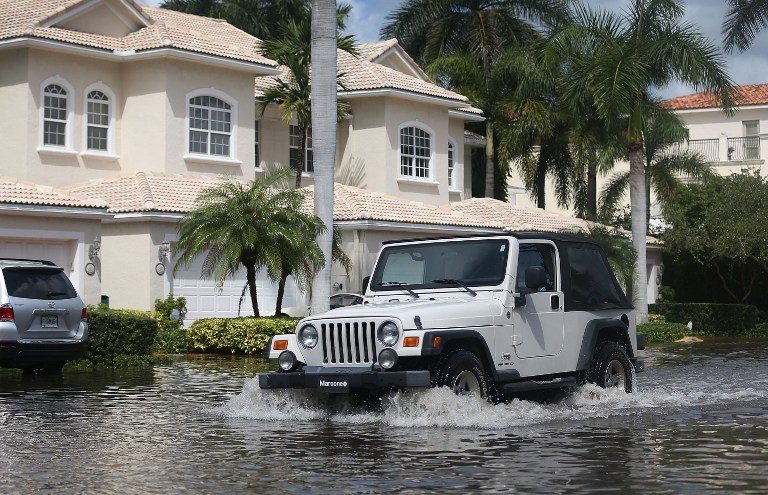SUMMARY
This is AI generated summarization, which may have errors. For context, always refer to the full article.

PARIS, France – Large swathes of Shanghai, Mumbai, New York and other cities, including those in the Philippines, will slip under the waves even if an upcoming climate summit limits global warming to 2ºC, scientists reported Sunday, November 8.
A 2ºC (3.6ºF) spike in Earth’s temperature would submerge land currently occupied by 280 million people, while an increase of 4ºC (7.2ºF) – humanity’s current trajectory – would cover areas lived on by more than 600 million, the study said.
“Two degrees Celsius warming will pose a long-term, existential danger to many great coastal cities and regions,” said lead author Ben Strauss, vice president for sea level and climate impacts at Climate Central, a US-based research group.
Sea level rises corresponding to these 2ºC or 4ºC scenarios could unfold in two hundred years, but would more likely happen over many centuries, perhaps as long as 2,000 years, according to the research, published by Climate Central.
Capping the rise in Earth’s temperatures to 2ºC above pre-industrial levels is the core goal of the 195-nation UN climate summit in Paris from November 30 to December 11.
The most effective way to slow global warming is to slash the output of the greenhouse gases which drive it.
But even if emissions reduction pledges – many of them conditioned on financial aid – submitted by 150 nations ahead of the Paris summit are fulfilled, it would still put us on a pathway for a 3ºC (4.8ºF) world, the United Nations has warned.
Achieving the two-degree goal remains a serious challenge.
Strauss and colleagues apply on a global scale the same methodology they used for a recent study that focused on temperature-linked sea level rise in the United States, published in the US Proceedings of the National Academy of Sciences.
That study concluded that both Miami and New Orleans are doomed to crippling impacts.
In the new report, the country hit hardest by sea level rise under a 4ºC scenario is China.
Today, some 145 million people live in Chinese cities and coastal areas that would eventually become ocean were temperatures to climb that high.
Four of the 10 most devastated megacities would be Chinese: land occupied today by 44 million people in Shanghai, Tianjin, Hong Kong and Taizhou would be underwater.
India, Vietnam and Bangladesh do not fare much better. All told, Asia is home to 75% of the populations that today reside in zones that would no longer be classified as land in a climate-altered future.
Thirty-four million people in Japan, 25 million the United States, 20 million in the Philippines, 19 million Egypt and 16 million in Brazil are also in future 4ºC seascapes.
‘Line between land and sea’
While the 2ºC scenario is also grim, limiting warming to that extent would spare China and other nations much misery, said Strauss.
“There is a world of difference between 2ºC and 4ºC, which threatens more than double the damage,” he told Agence France-Presse. “We have a very large choice ahead of us.”
The sea level rise corresponding to 2ºC would eventually be 4.7 metres, and for 4ºC almost double that, the study found.
The projections are based on climate models taking into account the expansion of ocean water as it warms, the melting of glaciers, and the decay of both the Greenland and West Antarctic icesheets.
Timing is harder to predict, Strauss said: “It is easier to estimate how much ice will eventually melt from a certain amount of warming than how quickly it will melt.”
Normally a study of this nature would be published by a peer-reviewed journal, as was the earlier research on the US.
In this case, however, Strauss felt that the new results should be taken into account ahead of the crucial climate summit in Paris.
“These findings seemed too relevant to COP21” – the 21st Conference of the Parties, the official name for the UN climate meeting – “to risk that they be published afterwards,” he said.
Agence France-Presse sent the study to 4 experts – including Jean-Pascal van Ypersele, until this year Vice-President of the UN’s Intergovernmental Panel on Climate Change – for evaluation, and all of them described the work as “solid” and methodologically sound.
Strauss said his study shows that the stakes at the Paris negotiations are extremely high.
“Some historic meetings draw national boundaries,” he told Agence France-Presse. “This one will affect the global line between land and sea.”
An interactive map showing impacts at different temperature scenarios is available at choices.climatecentral.org. – Marlowe Hood, AFP / Rappler.com
Add a comment
How does this make you feel?
There are no comments yet. Add your comment to start the conversation.